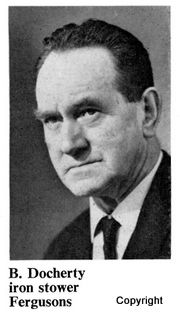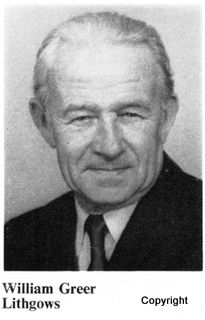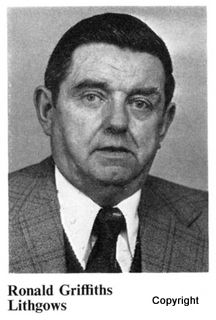
INVERCLYDE SHIPBUILDING
Lithgows
Taken from ‘British Shipbuilding Yards’ Vol 2 by Norman L Middlemiss
This prolific shipbuilding company was known as Russell & Co until 1918, and from beginnings in one small yard, was eventually to take over all of the other large port Glasgow shipyards. Joseph Russell was born in London in 1833, the son of a Baptist minister, and began his apprenticeship with JW Hoby & Co, Renfrew, later William Simons & Co, and then joined Lawrence Hill in his Inch yard at Port Glasgow. When the Inch yard was sold to Cunliffe & Dunlop in 1869 Joseph Russell returned to London, but an opportunity arose in 1874 for him to form a partnership with Anderson Rodger(born 1843) and William Todd Lithgow(born 1854) to lease the Bay yard in east Port Glasgow. WT Lithgow had been apprenticed to John Reid in 1872 at the Glen yard, and this was the start of an exceptional shipbuilding legend which encompassed over a century of Port Glasgow shipbuilding history.
The three partners succeeded in making a profit of just under £10000 in the two years to the end of 1876, with each partner having withdrawn £380. They then built in their Bay yard their famous barque Falls of Clyde in 1878, still preserved in Honolulu, and then expanded in 1879 by purchasing the Cartsdyke Mid yard at Greenock. In 1881 they acquired their third and most important yard from Henry Murray, the Kingston yard at Port Glasgow. The six berth Kingston yard was rebuilt and enlarged under its manager Alexander Lambie and the partners Russell, Rodger and Lithgow then exploited the market for large capacity sailing ships, which were the only practical way of carrying bulk cargoes around the world at this time until the triple expansion engine was further developed for the steam tramp. Fast clippers were not built, but a determined policy of standardisation as used by Connell at Scotstoun at the same time, reaped its reward in productivity. During the ten years from 1882 – 1892 the three yards with 14 berths were head of the river with some 271 ships built, and in 1890 they captured the world output record with a total of 70,370 tons in 26 sailing ships and eight steam tramps.
The standardisation policy was carried through to such an extent that only sailing ships were built at the Kingston yard, with standard tramp hulls at the Bay and Greenock yards. A financial interest was taken by the partners in many of the ships, and some were built ‘on spec’ and if a buyer could not be found then it was traded by the partners.
The partnership between Russell, Rodger and Lithgow was broken up in November 1891 when Russell retired, with Rodger taking the Bay yard and building under his own name and Lithgow taking the Kingston and Greenock yards while still using the title Russell & Co. Joseph Russell loaned Lithgow £122,965 at this time, and agreed to assist him by preparing the annual accounts and in purchasing timber.
The Mid Cartsdyke yard was sold to the Greenock & Grangemouth Dockyard Co ltd in 1900, leaving William T Lithgow with the Kingston yard. His trading profit for 1900 was a considerable £123,600, with steam tramps for local owners then becoming the bread and butter of the yard.
William T Lithgow had married in 1879 Agnes Birkmyre, the daughter of Henry Birkmyre, owner of Gourock Ropeworks, and grand daughter of John Birkmyre, a wealthy Lower Clyde merchant and investor in the Burrell fleet of tramps. Their first child was a daughter, Margaret, then their first son James was born 1883 followed by Henry in 1886, the latter at a house called Drums. The couple had rented Drums but when they became more prosperous the house was purchased and also by 1900 William had paid off half of the loan from Russell. In 1902 he bought the Ormsary estate. Their elder son James started as an apprentice at the Kingston yard in 1901 and both James and Henry were taken into partnership in 1907. On 7th June 1908 William T Lithgow died leaving over £1m in his will with £102,000 invested in ships. He had withdrawn £1.2m from the business since the formation of the partnership in 1874, and had turned his original investment of £10,000 into almost £2m
James was aged 25 years and Henry 22 when they assumed full ownership of the Kingston yard. The brothers had a secure family and financial background to draw upon, and expanded in 1911 by acquiring the Bay yard after the death of Anderson Rodger in 1909. Family sentiment coupled with hard-headed business acumen to prevent new competition entering the Port Glasgow yards had influenced their decision. In 1911 James was appointed Vice President of the Clyde Shipbuilders Association, and served as their President during 1912/13. he made his first contacts at this time with tow men who later were valuable colleagues: Andrew Duncan, and Alexander Belch, later controller of the Shipbuilding Conference.
Russell & Co entered the Great War with the Kingston and Bay yards and in 1915 the East Yard of Robert Duncan & Co was purchased but continued to build under its own name, and in 1917 the Lithgow brothers bought into the Glasgow marine engineers David Rowan & Co ltd.
Henry ran the yards while his brother James served as Director of Merchant Shipbuilding on his return from France in May 1917, having reached the rank of Colonel after 15 months at the battlefront. At the end of the war came the renaming of Russell & Co into Lithgow’s.
The Inch yard of Dunlop, Bremner & Co ltd was purchased in 1919 but continued to build under its own name until 1926. The Glen yard of William Hamilton was purchased in 1919 and with the closure of the small yard of Murdoch and Murray in 1923 the Lithgow Brothers then owned all of the Port Glasgow yards along the waterfront stretching from the Kingston to Bay yards inclusive. The steel stockists James Dunlop & Co Ltd was purchased in 1920 to ensure steel supplies and the Greenock marine engineers Rankin, Blackmore & Co Ltd in 1923 for a supply of engines.
When James Lithgow had acquired the Glen yard from William Hamilton in 1919 he made the Glen offices his working headquarters, with Henry having his offices in the East yard, and both men used the same car to work from their home, Drums. At lunch time they walked to the Kingston yard to have lunch with yard manager John Muirhead and sort out any problems. James was knighted in 1925, shortly after his marriage in September 1924 to Gwendolyn Amy Harrison, daughter of a Glasgow shipowner who had previously ordered ships from his new son-in-law. Lady Lithgow laid the keystone for their new home at Gleddoch, one mile west of Drums, on 12th June 1925, and the couple were subsequently to have three children, the eldest Margaret, then Ann and finally a son named William.
Lithgow’s were the least affected yard during the Depression due to their ability to cut prices.
Sir James Lithgow approached Montagu Norman, Governor of the Bank of England, to set up National Shipbuilders Security Ltd in 1930 with Sir James as Chairman, during the necessary rationalisation of yard capacity of that time. NSS Ltd was formed to secure a core price for the building rights of any yard going into liquidation, and was financed by shares taken up by shipbuilders participating in the company and a 1% levy on the value of tonnage launched. Between 1931 and 1937 the company acquired all or part of the building rights on nine Clyde yards, with the Lithgow brothers having interests in five of these. They effectively used NSS Ltd to extend their own process of rationalisation at Port Glasgow and in particular received considerable compensation when the Lithgow owned Inch yard was sold to NSS Ltd in 1933 and the site sterilised for forty years. Public opinion was outraged, however the money was put to good use when the brothers purchased the famous Fairfield yard at Govan in 1935 and saved it from closure.
The Bay yard was closed at the end of the Depression in 1935 and demolished. The six berth East yard, formerly that of Robert Duncan & Co Ltd although owned by Lithgow since 1915, had closed due to the depression in 1931 but re-opened in April 1937, under the Lithgow name. The Kingston yard now had nine berths and the east yard with six now made a total of fifteen berths available.
During WWII a huge total of 97 ships of over 1.2m tons was completed.
John Muirhead, Managing Director of the Port Glasgow yards, retired in 1946 after spending all of his working life working for the Lithgow brothers. Henry Lithgow had never married, but before his death on 28th May 1948 at his home of Drums this cautious, genial, pipe-smoking man sketched out some early plans for prefabrication production at the Kingston yard, which unfortunately were not implemented until 1960. His brother Sir James Lithgow suffered a thrombosis in Sept 1948 near Gleddoch, and was to remain struggling to walk and regain his health for the remaining three and a half years of his life. In 1949 he relinquished responsibility for the redevelopment of the Beardmore yard and set up Scottish Ore Carriers Ltd to ensure ore supplies reached Scottish smelters in Port Glasgow-built ships. He died on 23rd February 1952 at Gleddoch having been in control of the greatest Scottish shipbuilding group for a continuous 44 years. He was buried at Ormsary. On his gravestone was ‘continuing the work of their father, he and his brother Henry built ships at Port Glasgow’
Management structure after the deaths of the Lithgow brothers was simple and straightforward, consisting of three exec directors with a shipyard manager and two asst managers in each yard. In 1959 an ambitious restructuring of the yard began. A feature was a large number of long prefab shops running parallel to the Clyde. Some ships were fitted out at the Kingston basin, others were completed at Finnieston where Rowan-built engines were fitted, or in the James Watt Dock where Rankin & Blackmore engines were fitted. The East yard then merged with the Glen yard of William Hamilton in 1963 and was then modernised.
The Geddes report recommended mergers of British shipyards and Scotts and Lithgow’s merged in 1968. The small yards of Ferguson Brothers acquired by Lithgow’s in 1961 and Scott & Sons of Bowling were also included but Ferguson’s later withdrew to join forces with Ailsa Shipbuilding Co Ltd. Rankin & Blackmore closed in 1964, and Campbeltown Shipyard Ltd was purchased in 1970.
The large Inchgreen dry-dock, built in 1964 was purchased from the Firth of Clyde Dry dock Co Ltd in 1966. It had been built on the site of the old Inch shipyard.
The Glen/East yard was absorbed into the Kingston yard in 1972 to form one ‘super’ yard
The Scott-Lithgow yards came under state ownership as part of British Shipbuilders Ltd on 1st July 1977.
With no further orders the yard turned to rig construction. Sea Explorer and Ocean Alliance were built after some trouble and after being sold to Trafalgar House and Howard Doris in 1984.
A huge total of over 1200 ships have been built by the Lithgow yards under the Russell and Lithgow names, with several hundred more by subsidiaries under their own names. The Lithgow family diversified their interests into electronics by setting up Lithgow Electronics Ltd and into hotels by purchasing the Tontine Hotel of 1805 in 1971.


Lithgow Men from the Scott Lithgow House Magazine
















































